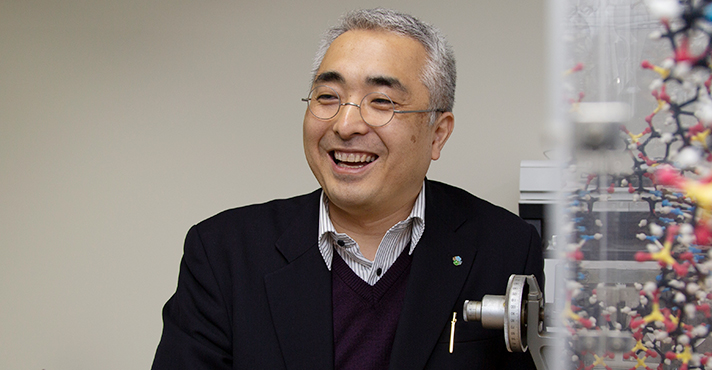
Professor Genji Kurisu, Division of Protein Structural Biology, Institute for Protein Research
“The secret adaptive power of photosynthetic complex I is finally revealed”
An international team including researchers from Osaka University has solved the structure of photosynthetic complex I using cryo-electron microscopy. Using integrative structural biological methods, Dr. Genji Kurisu and his team were also able to demonstrate the role of the complex in the electron transfer process, particularly its interaction with ferredoxin. Their finding entitled “Structural adaptations of photosynthetic complex I enable ferredoxin-dependent electron transfer” was published in Science.
Tell us a bit about the background of this research.
Life on Earth depends ultimately on sunlight, through the process of photosynthesis. The photosynthetic electron transport chain is a tiny solar power plant used to drive photosynthesis. It is thought to have three integral membrane protein complexes: Photosystem II, Cytochrome b 6 f complex, and Photosystem I (PSI), which are electrically connected by the lipophilic mobile carrier Plastoquinone (PQ) and the soluble electron carrier proteins Plastocyanin and Ferredoxin (Fd). Because the X-ray structures of all of the above protein complexes had been reported previously, it was widely believed that the details of photosynthetic electron transfer were already well understood.

Quite recently, however, a fourth membrane protein complex, a photosynthetic complex I named NADH dehydrogenase-like complex 1 (NDH1), has been identified and reported to mediate a cyclic electron flow around PSI, which is physiologically important in balancing the electron transport and generation of the trans-membrane electrochemical proton gradient in oxygenic photosynthesis.
Since no direct information about the electron donor to NDH1 had been reported thus far, understanding how NDH1 delivers the reducing equivalents to the thylakoid membrane back from the stromal space of chloroplast remained a major challenge for us.
What did your team accomplish through this joint research project?
Our international collaborative team, consisting of researchers from Osaka University, the Max Planck Institute for Biochemistry, and Ruhr-Universität Bochum, together with our collaborative partners, has revealed how NDH1 mediates the cyclic electron flow around PSI and evolved distinctively from its respiratory analogues through integrative use of cryo-electron microscopy, X-ray crystallography, and NMR spectroscopy. Our structural work on NDH1 allows us to shed light on the cyclic electron transport pathways which, until recently, had little atomistic information.

What is the appeal of international collaboration?
This work is based on 10 years of international collaboration between Bochum and Osaka, the two labs of which provide each other with significant advantages in their complementary disciplines. I strongly believe that international collaboration is the perfect opportunity to cultivate more hybrid and integrative seeds of scientific research. This successful collaborative project is supported in part by the International Joint Research Promotion Program at Osaka University.
For more information:
http://www.protein.osaka-u.ac.jp/crystallography/EngHP/Research.html
Text: Saori Obayashi/Edit: Christopher Bubb